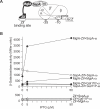Twin RNA polymerase-associated proteins control virulence gene expression in Francisella tularensis
- PMID: 17571921
- PMCID: PMC1891329
- DOI: 10.1371/journal.ppat.0030084
Twin RNA polymerase-associated proteins control virulence gene expression in Francisella tularensis
Abstract
The MglA protein is the only known regulator of virulence gene expression in Francisella tularensis, yet it is unclear how it functions. F. tularensis also contains an MglA-like protein called SspA. Here, we show that MglA and SspA cooperate with one another to control virulence gene expression in F. tularensis. Using a directed proteomic approach, we show that both MglA and SspA associate with RNA polymerase (RNAP) in F. tularensis, and that SspA is required for MglA to associate with RNAP. Furthermore, bacterial two-hybrid and biochemical assays indicate that MglA and SspA interact with one another directly. Finally, through genome-wide expression analyses, we demonstrate that MglA and SspA regulate the same set of genes. Our results suggest that a complex involving both MglA and SspA associates with RNAP to positively control virulence gene expression in F. tularensis. The F. tularensis genome is unusual in that it contains two genes encoding different alpha subunits of RNAP, and we show here that these two alpha subunits are incorporated into RNAP. Thus, as well as identifying SspA as a second critical regulator of virulence gene expression in F. tularensis, our findings provide a framework for understanding the mechanistic basis for virulence gene control in a bacterium whose transcription apparatus is unique.
Conflict of interest statement
Figures






Similar articles
-
Polyphosphate Kinase Antagonizes Virulence Gene Expression in Francisella tularensis.J Bacteriol. 2018 Jan 10;200(3):e00460-17. doi: 10.1128/JB.00460-17. Print 2018 Feb 1. J Bacteriol. 2018. PMID: 29158241 Free PMC article.
-
Dissection of the molecular circuitry controlling virulence in Francisella tularensis.Genes Dev. 2017 Aug 1;31(15):1549-1560. doi: 10.1101/gad.303701.117. Epub 2017 Sep 1. Genes Dev. 2017. PMID: 28864445 Free PMC article.
-
Small molecule control of virulence gene expression in Francisella tularensis.PLoS Pathog. 2009 Oct;5(10):e1000641. doi: 10.1371/journal.ppat.1000641. Epub 2009 Oct 30. PLoS Pathog. 2009. PMID: 19876386 Free PMC article.
-
Molecular and genetic basis of pathogenesis in Francisella tularensis.Ann N Y Acad Sci. 2007 Jun;1105:138-59. doi: 10.1196/annals.1409.010. Epub 2007 Mar 29. Ann N Y Acad Sci. 2007. PMID: 17395737 Review.
-
Diverse molecular mechanisms of transcription regulation by the bacterial alarmone ppGpp.Mol Microbiol. 2022 Feb;117(2):252-260. doi: 10.1111/mmi.14860. Epub 2021 Dec 25. Mol Microbiol. 2022. PMID: 34894005 Free PMC article. Review.
Cited by
-
A response regulator promotes Francisella tularensis intramacrophage growth by repressing an anti-virulence factor.Mol Microbiol. 2016 Aug;101(4):688-700. doi: 10.1111/mmi.13418. Epub 2016 Jun 10. Mol Microbiol. 2016. PMID: 27169554 Free PMC article.
-
Environmental and intracellular regulation of Francisella tularensis ripA.BMC Microbiol. 2009 Oct 12;9:216. doi: 10.1186/1471-2180-9-216. BMC Microbiol. 2009. PMID: 19821974 Free PMC article.
-
Outsmarting the host: bacteria modulating the immune response.Immunol Res. 2008;41(3):188-202. doi: 10.1007/s12026-008-8021-5. Immunol Res. 2008. PMID: 18592144
-
Exploitation of host cell biology and evasion of immunity by francisella tularensis.Front Microbiol. 2011 Jan 13;1:145. doi: 10.3389/fmicb.2010.00145. eCollection 2010. Front Microbiol. 2011. PMID: 21687747 Free PMC article.
-
Transcription Elongation Factor GreA Plays a Key Role in Cellular Invasion and Virulence of Francisella tularensis subsp. novicida.Sci Rep. 2018 May 2;8(1):6895. doi: 10.1038/s41598-018-25271-5. Sci Rep. 2018. PMID: 29720697 Free PMC article.
References
-
- Oyston PCF, Sjostedt A, Titball RW. Tularemia: Bioterrorism defence renews interest in Francisella tularensis . Nat Rev Microbiol. 2004;2:967–978. - PubMed
-
- Baron GS, Nano FE. MglA and MglB are required for the intramacrophage growth of Francisella novicida . Mol Microbiol. 1998;29:247–259. - PubMed
-
- Gray CG, Cowley SC, Cheung KKM, Nano FE. The identification of five genetic loci of Francisella novicida associated with intracellular growth. FEMS Microbiol Lett. 2002;215:53–56. - PubMed
Publication types
MeSH terms
Substances
Grants and funding
LinkOut - more resources
Full Text Sources
Other Literature Sources

